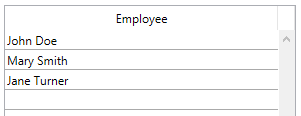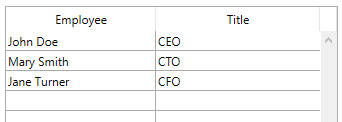This is the legacy 4D documentation web site. Documentations are progressively being moved to developer.4d.com
- 4D Language Reference
-
- List Box
-
-
 Managing List Box Objects
Managing List Box Objects
-
 List Box Commands Summary
List Box Commands Summary
-
 LISTBOX COLLAPSE
LISTBOX COLLAPSE
-
 LISTBOX DELETE COLUMN
LISTBOX DELETE COLUMN
-
 LISTBOX DELETE ROWS
LISTBOX DELETE ROWS
-
 LISTBOX DUPLICATE COLUMN
LISTBOX DUPLICATE COLUMN
-
 LISTBOX EXPAND
LISTBOX EXPAND
-
 LISTBOX Get array
LISTBOX Get array
-
 LISTBOX GET ARRAYS
LISTBOX GET ARRAYS
-
 LISTBOX Get auto row height
LISTBOX Get auto row height
-
 LISTBOX GET CELL COORDINATES
LISTBOX GET CELL COORDINATES
-
 LISTBOX GET CELL POSITION
LISTBOX GET CELL POSITION
-
 LISTBOX Get column formula
LISTBOX Get column formula
-
 LISTBOX Get column width
LISTBOX Get column width
-
 LISTBOX Get footer calculation
LISTBOX Get footer calculation
-
 LISTBOX Get footers height
LISTBOX Get footers height
-
 LISTBOX GET GRID
LISTBOX GET GRID
-
 LISTBOX GET GRID COLORS
LISTBOX GET GRID COLORS
-
 LISTBOX Get headers height
LISTBOX Get headers height
-
 LISTBOX GET HIERARCHY
LISTBOX GET HIERARCHY
-
 LISTBOX Get locked columns
LISTBOX Get locked columns
-
 LISTBOX Get number of columns
LISTBOX Get number of columns
-
 LISTBOX Get number of rows
LISTBOX Get number of rows
-
 LISTBOX GET OBJECTS
LISTBOX GET OBJECTS
-
 LISTBOX GET PRINT INFORMATION
LISTBOX GET PRINT INFORMATION
-
 LISTBOX Get property
LISTBOX Get property
-
 LISTBOX Get row color
LISTBOX Get row color
-
 LISTBOX Get row color as number
LISTBOX Get row color as number
-
 LISTBOX Get row font style
LISTBOX Get row font style
-
 LISTBOX Get row height
LISTBOX Get row height
-
 LISTBOX Get rows height
LISTBOX Get rows height
-
 LISTBOX Get static columns
LISTBOX Get static columns
-
 LISTBOX GET TABLE SOURCE
LISTBOX GET TABLE SOURCE
-
 LISTBOX INSERT COLUMN
LISTBOX INSERT COLUMN
-
 LISTBOX INSERT COLUMN FORMULA
LISTBOX INSERT COLUMN FORMULA
-
 LISTBOX INSERT ROWS
LISTBOX INSERT ROWS
-
 LISTBOX MOVE COLUMN
LISTBOX MOVE COLUMN
-
 LISTBOX MOVED COLUMN NUMBER
LISTBOX MOVED COLUMN NUMBER
-
 LISTBOX MOVED ROW NUMBER
LISTBOX MOVED ROW NUMBER
-
 LISTBOX SELECT BREAK
LISTBOX SELECT BREAK
-
 LISTBOX SELECT ROW
LISTBOX SELECT ROW
-
 LISTBOX SELECT ROWS
LISTBOX SELECT ROWS
-
 LISTBOX SET ARRAY
LISTBOX SET ARRAY
-
 LISTBOX SET AUTO ROW HEIGHT
LISTBOX SET AUTO ROW HEIGHT
-
 LISTBOX SET COLUMN FORMULA
LISTBOX SET COLUMN FORMULA
-
 LISTBOX SET COLUMN WIDTH
LISTBOX SET COLUMN WIDTH
-
 LISTBOX SET FOOTER CALCULATION
LISTBOX SET FOOTER CALCULATION
-
 LISTBOX SET FOOTERS HEIGHT
LISTBOX SET FOOTERS HEIGHT
-
 LISTBOX SET GRID
LISTBOX SET GRID
-
 LISTBOX SET GRID COLOR
LISTBOX SET GRID COLOR
-
 LISTBOX SET HEADERS HEIGHT
LISTBOX SET HEADERS HEIGHT
-
 LISTBOX SET HIERARCHY
LISTBOX SET HIERARCHY
-
 LISTBOX SET LOCKED COLUMNS
LISTBOX SET LOCKED COLUMNS
-
 LISTBOX SET PROPERTY
LISTBOX SET PROPERTY
-
 LISTBOX SET ROW COLOR
LISTBOX SET ROW COLOR
-
 LISTBOX SET ROW FONT STYLE
LISTBOX SET ROW FONT STYLE
-
 LISTBOX SET ROW HEIGHT
LISTBOX SET ROW HEIGHT
-
 LISTBOX SET ROWS HEIGHT
LISTBOX SET ROWS HEIGHT
-
 LISTBOX SET STATIC COLUMNS
LISTBOX SET STATIC COLUMNS
-
 LISTBOX SET TABLE SOURCE
LISTBOX SET TABLE SOURCE
-
 LISTBOX SORT COLUMNS
LISTBOX SORT COLUMNS
-
 LISTBOX INSERT COLUMN FORMULA
LISTBOX INSERT COLUMN FORMULA
| LISTBOX INSERT COLUMN FORMULA ( {* ;} object ; colPosition ; colName ; formula ; dataType ; headerName ; headerVar {; footerName ; footerVar} ) | ||||||||
| Parameter | Type | Description | ||||||
| * | Operator |

|
If specified, object is an object name (string) If omitted, object is a variable | |||||
| object | Form object |

|
Object name (if * is specified) or Variable (if * is omitted) | |||||
| colPosition | Longint |

|
Location of column to insert | |||||
| colName | String |

|
Name of the column object | |||||
| formula | String |

|
4D formula associated with column | |||||
| dataType | Longint |

|
Type of formula result | |||||
| headerName | String |

|
Name of the column header object | |||||
| headerVar | Integer variable, Nil pointer |

|
Column header variable | |||||
| footerName | String |

|
Column footer object name | |||||
| footerVar | Variable, Nil pointer |

|
Column footer variable | |||||
The LISTBOX INSERT COLUMN FORMULA command inserts a column into the list box designated by the object and * parameters.
The LISTBOX INSERT COLUMN FORMULA command is similar to the LISTBOX INSERT COLUMN command except that it can be used to enter a formula as the contents of a column.
This type of contents can only be used when the “Data Source” property of the list box is set to Current Selection, Named Selection, or Collection or Entity Selection (for more information about this, please refer to the Managing List Box Objects section).
Note: This command does nothing if it is applied to the first column of a list box displayed in hierarchical mode.
If you pass the optional * parameter, you indicate that the object parameter is an object name (string). If you do not pass this parameter, you indicate that the object parameter is a variable. In this case, you pass a variable reference instead of a string. For more information about object names, please refer to the Object Properties section.
The new column is inserted just before the column designated by the colPosition parameter. If the colPosition parameter is greater than the total number of columns, the column will be added after the last column.
Pass the object name of the inserted column in the colName parameter.
The formula parameter can contain any valid expression, i.e.:
- An instruction,
- A formula generated using the Formula editor,
- A call to a 4D command,
- A call to a project method.
At the moment the command is called, the formula is parsed then executed.
Note: Use the Command name command in order to define formulas that are independent from the application language (when they call on 4D commands).
The dataType parameter can be used to designate the type of data resulting from the execution of the formula. You must pass one of the following constants of the “Field and Variable Types” theme in this parameter:
| Constant | Type | Value |
| Is Boolean | Longint | 6 |
| Is date | Longint | 4 |
| Is picture | Longint | 3 |
| Is real | Longint | 1 |
| Is text | Longint | 2 |
| Is time | Longint | 11 |
If the result of the formula does not correspond to the expected data type, an error is generated.
In the headerName and headerVar parameters, pass the object name and variable of the column header inserted.
In the footerName and footerVar parameters, you can also pass the object name and variable of the footer of the inserted column. If you omit the footerVar parameter, 4D uses a dynamic variable.
Note: Object names must be unique in a form. You need to make sure that the names passed in the colName, headerName and footerName parameters are not already used. Otherwise, the column is not created and an error is generated.
Starting with 4D v14 R3, you can use this command to insert columns into list boxes dynamically when the form is executed. 4D will automatically handle the definition of the necessary variables (footer and header).
To do this, LISTBOX INSERT COLUMN FORMULA accepts a Nil pointer (->[]) as a value for the headerVar and footerVar parameters. In this case, when the command is executed, 4D creates the required variables dynamically (for more information, refer to the section).
Note that header and footer variables are always created with a specific type (longint and text, respectively).
We want to add a new column to the right of the list box that will contain a formula which calculates an empolyee's age:
vAge:="Current Date-[Employees]BirthDate)\365"
$last:=LISTBOX Get number of columns(*;"ListBox1")+1
LISTBOX INSERT COLUMN FORMULA(*;"ListBox1";$last;"ColFormula";vAge;Is real;"Age";HeaderVar)You want to add column to a list box of collection type:
//create collection
C_COLLECTION(emps)
emps:=New collection(New object("Employee";"John Doe";"JobTitle";"CEO");New object("Employee";"Mary Smith";"JobTitle";"CTO");New object("Employee";"Jane Turner";"JobTitle";"CFO"))The column contents are evaluated for each element of the collection and referenced with the data source expression, This.Employee, as shown below:

At execution:

To add a column showing the job titles:
LISTBOX INSERT COLUMN FORMULA(*;"EmpLB";2;"2nd Column";"This.JobTitle";Is text;"JTHeader";header2)
OBJECT SET TITLE(header2;"Title")The column is added to the list box:

Product: 4D
Theme: List Box
Number:
970
Created: 4D v11 SQL
Renamed: 4D v12 (INSERT LISTBOX COLUMN FORMULA)
Modified: 4D v13
Modified: 4D v14 R3
Modified: 4D v17
4D Language Reference ( 4D v20 R7)









